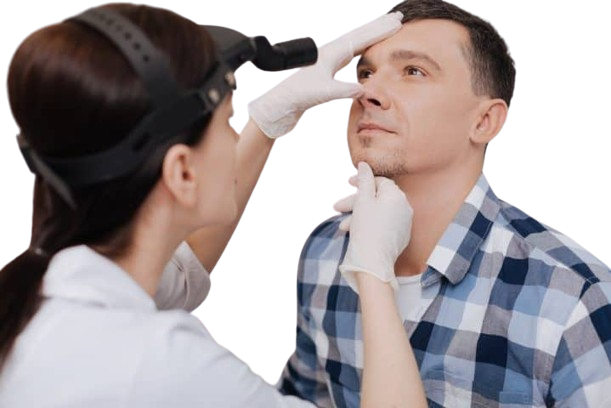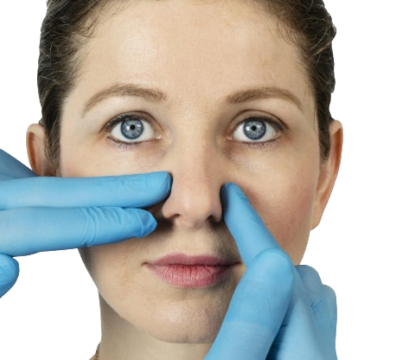Enlarged Turbinates Expert in Perumbakkam
Your Trusted Partner in Enlarged Turbinates
The nasal Turbinates are long, narrow passageways that help to warm and moisten the air that flows in through the nose. We are here to provide you with top-notch care and guidance to tackle your problems.

Understanding Enlarged Turbinates
Causes of Enlarged Turbinates
Turbinate hypertrophy can be acute or chronic. Some of the most common causes of the condition include:
- Chronic sinus inflammation
- Environmental irritants
- Seasonal allergies
Each of these conditions can cause the bone itself or the soft tissue of the turbinates to enlarge and swell. Many people with turbinate hypertrophy have a family history of allergic rhinitis

Symptoms of Enlarged Turbinates:
- Altered sense of smell
- Dry mouth upon awakening
- Forehead pressure
- Mild facial pain
- prolonged nasal congestion
- Runny nose
- snoring
Will Swollen Turbinates Go Away On Their Own?
Swollen turbinates may be manageable without surgical intervention in some cases. Suggested strategies include:
- Do not smoke: Smoking causes inflammation in the nasal passages and throughout the body. While this habit may not cause the turbinates to enlarge, it can exacerbate breathing difficulties.
- Perform saline nasal lavage: The nasal passages can accumulate mucus and bacteria. To wash substances away, many people rinse the nasal passages with saline nose drops. A solution can be made of 1 teaspoon of baking soda, 1 teaspoon of salt, and 2 cups of distilled water. This solution can be added to a bulb syringe or neti pot, both of which are used to stream the fluid into the nose. Excellent care of the syringe or neti pot is necessary to prevent bacteria from accumulating in them. Cleaning and care guidelines must be strictly followed.
- Use a humidifier or vaporizer: In rooms to support adequate nasal lubrication.
- Use over-the-counter nasal sprays or medications as directed: The overuse of certain types of medications can have an adverse effect that worsens nasal obstruction.
What are the treatments for Turbinate hypertrophy?
Reducing allergens in the home
One way to help treat symptoms of turbinate hypertrophy is to limit your exposure to environmental allergens. Here are some tips to help you achieve that:
- Make every effort to remove excess dust and pet dander from the home. This includes vacuuming carpets, pillows, drapes, and furniture to remove dust.
- Place fabric-covered toys in freezer bags and leave in the freezer for 24 hours. This can help to kill allergy-causing dust mites.
- Protect your mattress from dust mites by placing a dust-proof cover over the mattress.
- Refrain from smoking, especially indoors.
- Remove mold and mildew with specially formulated cleaners, especially in basements, bathrooms, and kitchens.
- Use a high-efficiency particulate air (HEPA) filter indoors. This filter can help to eliminate a significant amount of irritating dust in a room. The most effective place to use an air filter is in a bedroom, as it’s where you sleep. If you have indoor pets, keeping them out of your bedroom can help to reduce pet dander irritants.
Medications and at-home treatments
In addition to reducing allergens in the home, there are medications and at-home treatments that can help turbinate hypertrophy. These include:
- Taking medications to reduce seasonal allergies, such as cetirizine (Zyrtec) or loratadine (Claritin, Allegra).
- Taking oral decongestants, such as pseudoephedrine or phenylephrine. However, these medications can affect blood pressure and should be avoided by anyone who has blood pressure problems.
- Temporarily using nasal decongestants to relieve nasal swelling. However, these should not be used on a regular basis because they can result in bleeding and ineffectiveness over time.
Surgery
If your symptoms don’t respond to conservative treatments, a doctor may recommend surgery to reduce the size of the turbinates. There are three main surgical approaches to reducing turbinate hypertrophy:
- Inferior turbinate bone resection (ITBR): This involves removing a portion of bone of the inferior turbinates to promote airflow in the nose.
- Partial inferior turbinectomy (PIT): This procedure involves removing soft tissue of the inferior turbinate.
- Submucosal diathermy (SMD): This procedure involves using a special needle called a diathermy needle to use heat energy to shrink the soft tissue inside the turbinates.
Many different approaches to turbinate surgery exist. A doctor may make recommendations based on how severe your symptoms are. Turbinate surgery can be difficult because a doctor should not completely remove the turbinates since they serve an important purpose. If a doctor removed all of your Turbinates, you might experience a dry, stuffy nose on a permanent basis. Doctors call this “empty nose symdrome.”
Frequently Asked Question on Enlarged Turbinates
Yes, it is relatively common for individuals to have enlarged turbinates, especially if they have underlying conditions like allergies.
Yes, some individuals may have enlarged turbinates without significant symptoms. Treatment is typically recommended when symptoms affect quality of life.
Diagnosis involves a physical examination of the nose and may include imaging studies, such as a CT scan, to assess the size and structure of the turbinates.
Turbinate reduction is a surgical procedure to reduce the size of the turbinates, improving airflow. It can be done using various techniques, including radiofrequency ablation or partial removal.
Enlarged turbinates may be a chronic condition, but symptoms can be effectively managed with appropriate treatment.
Lifestyle changes, such as using air purifiers, maintaining good nasal hygiene, and managing allergies, can help alleviate symptoms associated with enlarged turbinates.
